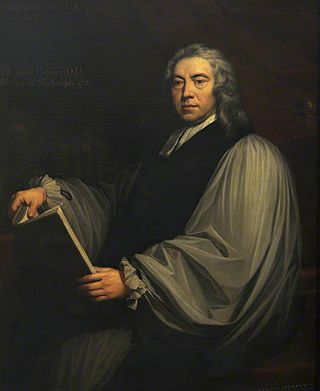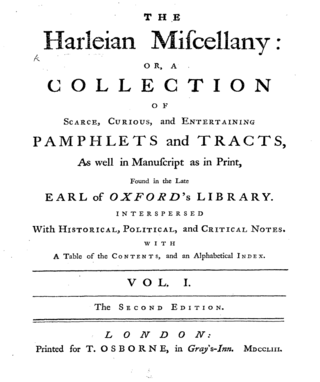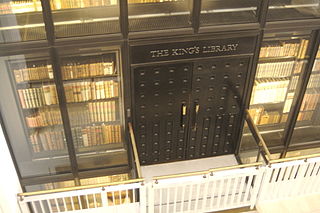Related Research Articles

The Bodleian Library is the main research library of the University of Oxford. Founded in 1602 by Sir Thomas Bodley, it is one of the oldest libraries in Europe. With over 13 million printed items, it is the second-largest library in Britain after the British Library. Under the Legal Deposit Libraries Act 2003, it is one of six legal deposit libraries for works published in the United Kingdom, and under Irish law it is entitled to request a copy of each book published in the Republic of Ireland. Known to Oxford scholars as "Bodley" or "the Bod", it operates principally as a reference library and, in general, documents may not be removed from the reading rooms.

John Evelyn was an English writer, landowner, gardener, courtier and minor government official, who is now best known as a diarist. He was a founding Fellow of the Royal Society.

John Selden was an English jurist, a scholar of England's ancient laws and constitution and scholar of Jewish law. He was known as a polymath; John Milton hailed Selden in 1644 as "the chief of learned men reputed in this land".

Thomas Tanner was an English antiquary and prelate. He was Bishop of St Asaph from 1732 to 1735.

Hannah More was an English religious writer, philanthropist, poet, and playwright in the circle of Johnson, Reynolds and Garrick, who wrote on moral and religious subjects. Born in Bristol, she taught at a school her father founded there and began writing plays. She became involved in the London literary elite and a leading Bluestocking member. Her later plays and poetry became more evangelical. She joined a group opposing the slave trade. In the 1790s she wrote Cheap Repository Tracts on moral, religious and political topics, to distribute to the literate poor. Meanwhile, she broadened her links with schools she and her sister Martha had founded in rural Somerset. These curbed their teaching of the poor, allowing limited reading but no writing. More was noted for her political conservatism, being described as an anti-feminist, a "counter-revolutionary", or a conservative feminist.

Henry Howard, 1st Earl of Northampton was an English aristocrat and courtier. He was suspected throughout his life of being Roman Catholic, and went through periods of royal disfavour, in which his reputation suffered greatly. He was distinguished for learning, artistic culture and his public charities. He built Northumberland House in London and superintended the construction of the fine house of Audley End. He founded and planned several hospitals. Francis Bacon included three of his sayings in his Apophthegms, and chose him as "the learnedest councillor in the kingdom to present to the king his Advancement of Learning." After his death, it was discovered that he had been involved in the murder of Sir Thomas Overbury.

Thomas Barlow was an English academic and clergyman, who became Provost of The Queen's College, Oxford, and Bishop of Lincoln. He was seen in his own time and by Edmund Venables in the Dictionary of National Biography to have been a trimmer, and have a reputation mixed with his academic and other writings on casuistry. His views were Calvinist and strongly anti-Catholic – he was among the last English bishops to dub the Pope Antichrist. He worked in the 1660s for "comprehension" of nonconformists, but supported a crackdown in the mid-1680s. Despite his anti-Catholic prejudices, Barlow declared loyalty to James II of England upon his accession.

The State Library of Württemberg is a large library in Stuttgart, Germany, which traces its history back to the ducal public library of Württemberg founded in 1765. It holds c. 4 million volumes and is thus the fourth-largest library in the state of Baden-Württemberg. The WLB owns an important collection of medieval manuscripts as well as one of the largest Bible collections in the world.
George Thomason was an English book collector. He is famous for assembling a collection of more than 22,000 books and pamphlets published during the time of the English Civil War and the interregnum.

The Harleian Miscellany is a collection of material from the library of the Earl of Oxford and Earl Mortimer collated and edited by Samuel Johnson and William Oldys between 1744 and 1753 on behalf of the publisher Thomas Osborne. Its subtitle was A Collection of Scarce, Curious, And Entertaining Pamphlets And Tracts, as well In Manuscript As In Print, Found In The Late Earl Of Oxford's Library, Interspersed With Historical, Political, And Critical Notes.
James Chaloner (1602–1660) was an English politician on the Parliamentary side in the English Civil War, and commissioner at the trial of King Charles I.

Humfrey Wanley was an English librarian, palaeographer and scholar of Old English, employed by manuscript collectors such as Robert and Edward Harley. He was the first keeper of the Harleian Library, now the Harleian Collection.

The British Library is a research library in London that is the national library of the United Kingdom. It is one of the largest libraries in the world. It is estimated to contain between 170 and 200 million items from many countries. As a legal deposit library, the British Library receives copies of all books produced in the United Kingdom and Ireland, including a significant proportion of overseas titles distributed in the United Kingdom. The Library is a non-departmental public body sponsored by the Department for Culture, Media and Sport.
Gerard Langbaine, the elder was an English academic and clergyman, known as a scholar, royalist, and Provost of Queen's College, Oxford during the siege of the city.

The King's Library was one of the most important collections of books and pamphlets of the Age of Enlightenment. Assembled by George III (r.1760–1820), this scholarly library of over 65,000 volumes was subsequently given to the British nation by his son, George IV. It was housed in a specially built gallery in the British Museum from 1827 to 1997 and now forms part of the British Library. The term "King's Library" was until recently also used to refer to the gallery in the British Museum built for the collection, which is now called the "Enlightenment Gallery" and displays a wide range of objects relating to the Enlightenment.
The Stowe manuscripts are a collection of about two thousand Irish, Anglo-Saxon and later medieval manuscripts, nearly all now in the British Library. The manuscripts date from 1154 to the end of the 14th century.
The British Library's Garrick Collection is a collection of early printed editions of English drama amassed by the actor and playwright David Garrick. The collection was bequeathed to the British Museum in 1779.

Rev. Jeremiah Milles (1714–1784) was President of the Society of Antiquaries and Dean of Exeter between 1762 and 1784. He carried out much internal renovation in Exeter Cathedral. As part of his antiquarian research into the history of the parishes of Devon he pioneered the use of the research questionnaire, which resulted in the "Dean Milles' Questionnaire", which survives as a valuable source of historical information.
The Minto Papers is a collection of family, estate and political manuscripts related to the family of Gilbert Elliot-Murray-Kynynmound, 1st Baron Minto and his descendants. The collection has in it over 2000 manuscript volumes. The bulk of the collection was initially purchased in 1958 by the National Library of Scotland (NLS), with later additions to the collection made by purchase and donation. The collection is stored at the NLS main building on George IV Bridge in Edinburgh, Scotland.
Reverend Charles Godwyn (1701-1770) was a cleric, antiquarian, and book collector at the University of Oxford. Born in Thornbury, Gloucestershire, Godwyn was descended from Thomas Godwin, the bishop of Bath and Wells. Godwyn studied at Balliol College, Oxford starting in 1718. He earned his BA in 1721 and his MA in 1724. Godwyn followed several members of his family into a career in the church and was ordained in 1727.
References
- Chisholm, Hugh, ed. (1911), , Encyclopædia Britannica , vol. 26 (11th ed.), Cambridge University Press, p. 868
- Gillies, Stewart (2013), "Thomason Collection of Civil War Tracts: History of the Collection and its Collector", British Library, archived from the original on 9 December 2008
- Stoker, David (1992), "Disposing of George Thomason's Intractable Legacy 1664–1762", The Library, 6th series, 14 (4): 337–356, doi:10.1093/library/s6-14.4.337 (subscription required) or Microsoft Word version on the author's website.